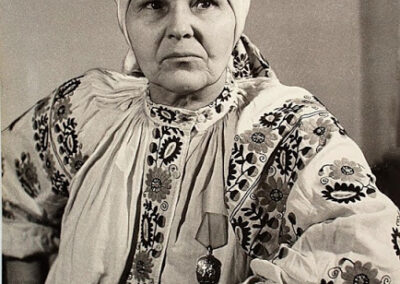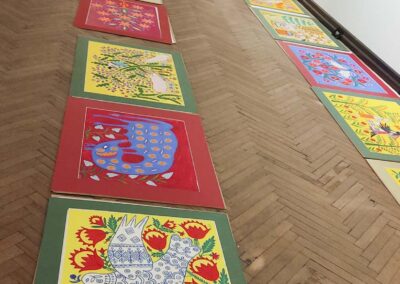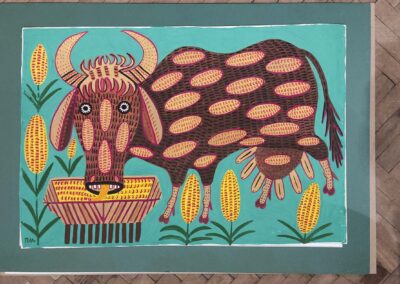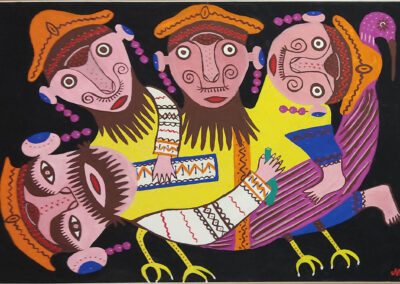Saving Maria Prymachenko artworks
Every day in Ukraine several civilian structures are damaged by bombings, among them the Museum of Local History of Ivankiv, where several works by Maria Prymachenko, Ukrainian painter, exponent of folk painting and naive style of Ukraine were kept, was burned during the invasion Russia, with the alleged loss of 25 of his works. However, according to journalist Tanja Goncharova, locals managed to save some of Prymachenko’s works from the fire.
A similar fate befalls the museum of the city of Zaporizhzhia from which about 100 works have instead been hidden in Lviv.
Following the objectives that we set ourselves with the Save Ukraine Art 22 project, we want to be able to bring the one hundred works of this interesting artist to Italy.
Maria Prymachenko
Maria Oksentiïvna Prymachenko Bolotnia, was one of the major exponents of folk painting and the naive style of Ukraine.
In 1966 she was awarded the Taras Shevchenko National Prize of Ukraine and in 1988 she was named People’s Artist of the Ukrainian SSR.
The United Nations Educational, Scientific and Cultural Organization (UNESCO) dedicated the year 2009 to her a street in Kiev and a minor planet are named after her.
After visiting an exhibition of hers in Paris, it seems that Pablo Picasso declared:
“I bow before the artistic miracle of this brilliant Ukrainian”.
ARTIST BIOGRAPHY
Marija Oksentiïvna Prymachenko was born in Ukraine and spent her entire life in the village of Bolotnja, in the Ivankiv district of Kiev Oblast, located just 30 kilometers from Chernobyl. Before falling ill with polio, a disease that made her disabled, she attended school for four years. The disease impacted her life and her art.
Maria Prymachenko comes from a creative family: her mother was an embroiderer, her father was a carpenter. During her childhood, Prymachenko’s mother taught her embroidery and in the late 1920s and early 1930s she was a member of the Ivankiv Cooperative Embroidery Association. Her daughter’s love for her drawing was always accepted and supported.
Maria began her journey with drawings in sand and clay. So she told herself: “Once near the house, above the river, on a flowery meadow, I was grazing some geese. She drew all kinds of flowers I’ve seen in the sand. And then she noticed a bluish ooze. I wrapped it in a veil and painted our house”
The neighbors liked the Prymachenkos’ house and began asking her to decorate their homes. The first payment for painting someone else’s house was a piglet. Thanks to that pig, the family was later able to survive in times of famine.
Besides painting houses and pictures, Maria was famous in the village for embroidering traditional ornamental cloths and clothes as well as extraordinary “Korovai” decorated bread used in weddings.
Unlike other artists who suffered under the Soviet regime, the union policy only helped Primachenko.
Since it was necessary to level everyone, in the 1930s the authorities collected the most talented people, and his talent was noticed by the artist Tetiana Floru, who in 1935 invited Prymachenko to work at the workshop of the Ukrainian Art Museum in Kiev and this was a decisive moment in his artistic and expressive career. The artist received no other art education, finishing only 4 classes of a normal secondary school.
Once in Kiev she underwent two operations which allowed her to stand on her own feet. In Kyiv-Pechersk Lavra, Maria Prymachenko. she met Vasyl Marynchuk, a young lieutenant with whom she had a son, Fedir. For some reason they never got married, after 5 years of married life Vasyl went to war and died in Finland. Around the same time Prymachenko’s brother was killed by the Nazis and she decided to return to Ivankiv, working on a collective farm. After the death of her partner, she Maria stopped painting for more than ten years.
The first Republican Exhibition of Folk Art, in 1936, exhibited Prymachenko’s paintings. This exhibition was presented in Moscow, Leningrad and Warsaw. Already at the first exhibition, Prymachenko’s paintings, then twenty-seven years old, were on display in a separate room. The exhibitions followed one another in Ukraine, Russia, Poland, France, the Czech Republic and in 1937 the artist’s works were exhibited in Paris, where she acquired a certain notoriety.
Her fame, however, in no way changed Maria’s life about her. She lived all her 88 years in her native village of Bolotnia, Kyiv region, and she didn’t even go to all those exhibitions
Prymachenko painted on plain Card all his life with ordinary tempera, watercolors and brushes made from cat hair.
Spanish artist Pablo Picasso saw Prymachenko’s paintings and was impressed. He is said to have called Prymachenko a genius and said that if he had lived in France, she might have surpassed him in popularity.
Support a specific project.
Adopt a specific project that inspires you or support a larger campaign. Explore the Foundation’s current projects.





